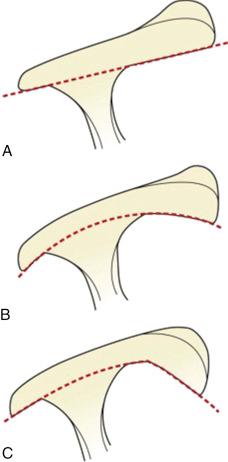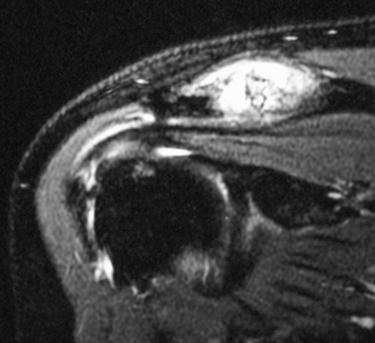Physical Address
304 North Cardinal St.
Dorchester Center, MA 02124
Shoulder pain is a common presenting complaint in patients of varying ages and activity levels. Cross-sectional studies have quantified the prevalence of shoulder pain in different countries as ranging from 4.7% to 46.7% in the general population. Although Neer clearly outlined the stages of impingement, interpreting epidemiologic trends of impingement syndrome can be challenging because the term is generically applied to a variety of shoulder pathologies. For the purposes of this chapter, impingement syndrome and acromioclavicular (AC) joint arthrosis are defined as (1) narrowing of the subacromial space with symptomatic encroachment of subacromial tissues and (2) symptomatic degenerative changes of the AC joint.
We prefer an arthroscopic approach for the surgical management of impingement syndrome and AC joint arthrosis. We begin with a diagnostic shoulder arthroscopy and proceed to a subacromial decompression consisting of a bursectomy, coracoacromial ligament release, and acromioplasty. Finally, for patients with symptomatic AC joint osteoarthritis, we perform an arthroscopic distal clavicle excision.
Background information should be obtained about patient hand dominance, occupation, activity level, and associated disability, as well as details of the presenting symptoms with regard to chronicity, duration, aggravating/alleviating factors, and context.
Patients with impingement typically describe the insidious onset of shoulder pain over a period of weeks to months, localized to the anterolateral acromion with radiation to the lateral aspect of the humerus.
Pain may be exacerbated by overhead activities of daily living such as combing one’s hair or reaching into high cupboards.
Although pain is most often the primary presenting complaint, associated symptoms, including weakness, decreased range of motion, and clicking and catching, may be present and should alert the physician to possible superimposed pathology.
Physical examination should begin with inspection of the scapula, shoulder, and humerus, followed by palpation of all bony prominences of the shoulder girdle.
The Neer impingement sign can be assessed with the examiner using one hand to prevent motion of the scapula while raising the arm of the patient with the other hand in forced elevation, eliciting pain (positive test) as the greater tuberosity impinges against the acromion (between 70 and 110 degrees of elevation).
The Hawkins impingement sign can be evaluated by flexing the patient’s shoulder to 90 degrees, flexing the elbow to 90 degrees, and forcibly internally rotating, driving the greater tuberosity farther under the coracoacromial ligament. If pain is elicited, the test result is considered positive for impingement.
Jobe test allows for assessment of impingement and/or supraspinatus weakness. The patient’s shoulder is abducted to 90 degrees, angled forward 30 degrees (bringing it into the scapular plane), and internally rotated (thumb pointing to floor). Subsequently, the examiner presses down on the patient’s arm while the patient attempts to maintain his/her extremity position. The result of this test is recorded as positive if the patient exhibits pain or weakness.
The Neer impingement test involves injecting the subacromial space with 10 mL of local anesthetic and observing an amelioration of pain with the aforementioned provocative tests.
For impingement specific to AC joint osteoarthritis, the cross-body adduction test is performed with the arm in 90 degrees of forward elevation and hyperadduction past the midline; if pain is localized to the AC joint, then the test result is considered positive.
Radiographs of the affected shoulder should include anteroposterior (AP), Grashey (AP view of shoulder in plane of scapula), outlet, and axillary views.
AP and Grashey views can depict anteroinferior acromion osteophytes, AC joint osteoarthritis, acromion sclerosis, and calcific tendinitis.
Outlet views can help further define acromion morphology according to Bigliani classification. Types II and III acromial morphology have higher rates of impingement ( Fig. 12.1 ).

Axillary views are used to assess for the presence of an os acromiale.
For evaluation of the AC joint, an AP view of bilateral AC joints and the Zanca view may be obtained.
In AC joint osteolysis, tapering of the distal clavicle can be seen in the late stages of the disease.
The use and timing of magnetic resonance imaging (MRI) in shoulder impingement syndrome remain controversial.
In impingement, MRI may demonstrate findings of subacromial bursitis, including bursal thickness greater than 3 mm, the presence of fluid medial to the AC joint, and the presence of fluid in the anterior aspect of the bursa.
For AC joint pathology, bone marrow edema in the distal clavicle as visualized in coronal plane MRI studies is a common finding and has a high correlation to the presence of symptoms ( Fig. 12.2 ).

Activity modification: patients should minimize overhead activities and other maneuvers that exacerbate shoulder symptoms for an extended period. It may be helpful to discuss “living within a window” in which patients consciously attempt to keep their hands within an area in front of their body during activity. The “window” should be from chest to waist and 2 to 3 feet wide, allowing the patient to avoid reaching overhead, away from the body, or behind the back, all of which can exacerbate their symptoms.
Nonsteroidal antiinflammatory drugs (NSAIDs), physical therapy: NSAIDs should be used as needed for pain relief. Patients may attend formal supervised physical therapy and then transition to a home exercise program. Useful exercises include rotator cuff strengthening, anterior and posterior shoulder range of motion, and periscapular stabilizing maneuvers.
Subacromial decompression: controversy still exists regarding what exact surgical procedures are performed during an arthroscopic subacromial decompression. For example, some surgeons may perform a bursectomy alone, whereas others recommend a bursectomy and anteroinferior acromioplasty.
Distal clavicle excision: this procedure can be performed arthroscopically or open. The arthroscopic approach to the AC joint can be subacromial (indirect) or superior (direct). The subacromial approach is used if coexisting shoulder pathology is suspected. If symptoms are isolated to the AC joint with no additional shoulder pathology suspected, the direct approach is preferred by some surgeons because it does not violate the subacromial bursa. An open distal clavicle excision can afford improved visualization. This procedure can be done through a small incision made over the AC joint.
Subacromial space/subacromial bursa
AC joint
Anterolateral acromion
Coracoacromial ligament
Deltoid muscle/deltoid fascia
Acromial branch of thoracoacromial artery
Persistent impingement symptoms that fail to improve with a nonoperative management course of 3 to 6 months
Symptomatic AC joint osteoarthritis that fails to improve with nonoperative management of 3 to 6 months
The patient is placed in the beach chair position with adequate exposure of both the anterior and posterior aspects of the operative shoulder.
The operative extremity is supported in a pneumatic limb positioner (SPIDER; TENET Medical Engineering, Calgary, AB, Canada).
A wedge is placed under the legs to prevent downward displacement of the patient.
The head is positioned on a well-padded head rest such that the neck is in neutral position with respect to flexion and extension.
The bed is rotated to place the operative shoulder at the center of the operating room.
When the patient is initially placed on the beach chair table, the posterior back pad should be brought over to the side of the operative shoulder. Once the patient is properly positioned and anesthetized, this post should be moved over to the contralateral shoulder, thereby exposing as much of the operative shoulder as possible.
To avoid the adverse effects of general anesthesia, a combination of regional anesthesia (for example, interscalene nerve block) and sedation is administered when possible.
The neck should be positioned in neutral with respect to the flexion–extension plane to allow for access to the airway as needed in cases of emergency.
Head tilt, especially toward the operative side, should be avoided because this can lead to collapse of drapes and thereby contaminate the surgical field, as well as to difficulty in establishing/maneuvering portals.
Standard 4.0-mm 30-degree arthroscope with inflow achieved via gravity or pump
3-L bags of normal saline hung at a height of approximately 7 feet to produce an adequate pressure gradient
5.5-mm full radius mechanized shaver for debridement of subacromial bursa
5.5-mm flat burr for contouring the undersurface of acromion and distal clavicle excision
Arthroscopic electrocautery/ablation device for achieving hemostasis as well as performing tissue debridement
Standard arthroscopic instruments should be available in case additional pathology is encountered.
A posterior portal is placed within the “soft spot” of the shoulder approximately 2 cm inferior and 1 cm medial to the posterolateral corner of the acromion.
An anterosuperior portal is made 2 cm distal to and in line with the AC joint to facilitate the distal clavicle excision.
A lateral portal is placed two fingerbreadths (approximately 3 cm) inferior to the lateral border of the acromion in line with the clavicle.
7-mm clear cannulas are used to facilitate instrument removal and insertion.
Become a Clinical Tree membership for Full access and enjoy Unlimited articles
If you are a member. Log in here